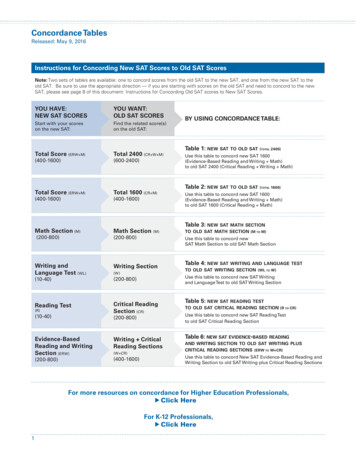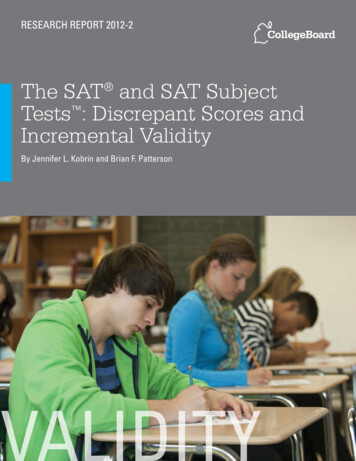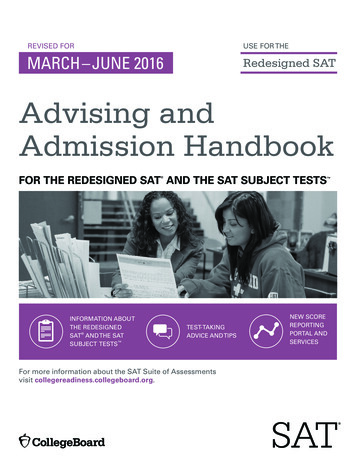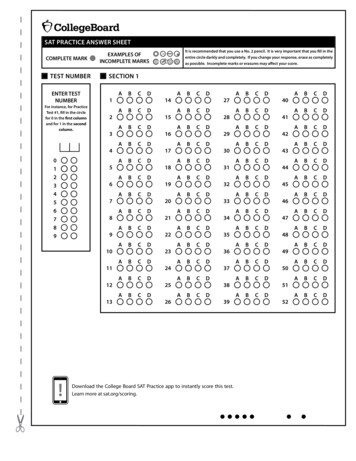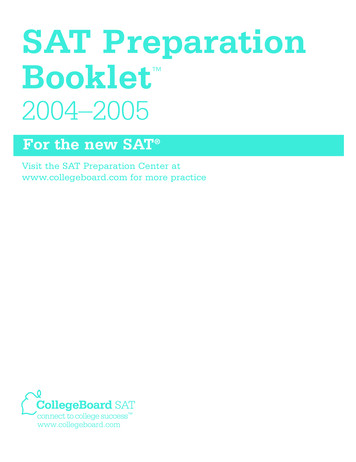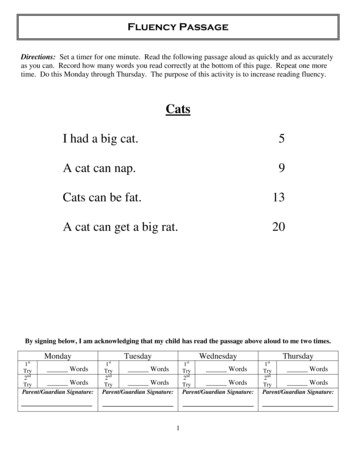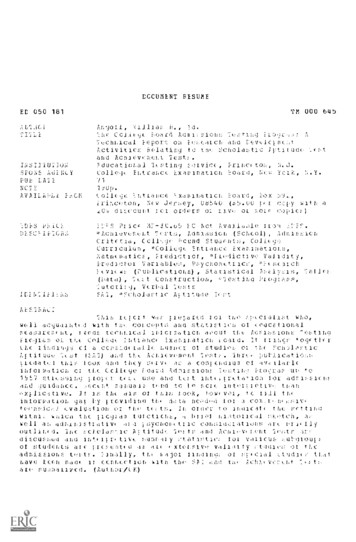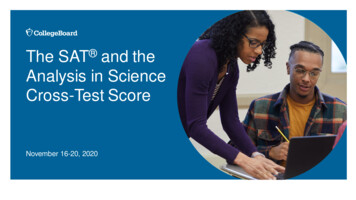
Transcription
The SAT and theAnalysis in ScienceCross-Test ScoreNovember 16-20, 2020
What we’ll covertoday: The Analysis in Science Cross-Test Score Review the Science Educator Guide and Science Teacher Toolkit The Analysis in Science Cross-Test Score and Associated Skills Focus on tools and strategies that support skills assessed on theSAT The SAT Suite Question Bank (SSQB) Explore science-related questions in the SSQB
What Is the Analysis in ScienceCross-Test Score?
SAT Scores andSubscores
Overview of ScienceEducator GuideThe field of science is represented in various ways on the threetests of the SAT Suite of Assessments.The Reading Test includes science passages coveringfoundational and applied topics in the field of science that may beaccompanied by informational graphics involving locating andinterpreting data and relating data to the information and main ideasin the passage.The Writing and Language Test highlights concepts, data, findings,and implications drawn from research.The Math Test assesses the ability to apply math knowledge andskills to solve problems and analyze data grounded in authentic,meaningful science contexts specifically by analyzing scientificscenarios and data while solving problems reflecting real-worldtasks in the sciences.5
Analysis in Science Cross-Test Score: SAT TestContribution to the Analysis in ScienceCross-Test ScoreReading21 questionsWriting and Language6 questionsMath8 questions6
Analysis in ScienceCross-Test Score:SAT Recurring themes related to the Analysis in Science cross-test score includethe following: Command of evidence (Reading; Writing and Language)Words in context (Reading; Writing and Language)Informational graphics (Reading; Writing and Language; Math)Multiple texts (Reading)Relationships (Reading)Logical sequence, transitions, syntax (Writing and Language)Problem solving and data analysis (Math)7
Analysis in Science Question: Reading TestWords in Context8
Analysis in ScienceQuestion: Math TestInformational Graphics9
Teacher ToolkitContentsTest SpecificationsTeacher Implementation GuideSkills InsightOfficial SAT Practice Lesson Plans
The Teacher Toolkithttps://www.isbe.net/Pages/sat-psat.aspx11
The Teacher t Specificationsfor the SATTeacher ImplementationGuideSkills InsightOfficial SAT PracticeLesson Plans12
Curriculum Review The Curriculum Review Worksheets are designed to help teachers understand many of the skills and knowledge that are assessed on the PSAT 8/9,PSAT 10, and SAT ; review student performance; identify skills and knowledge that need additional instruction and support; and develop a plan for implementation.The Curriculum Review Worksheets contain sets of tables addressing most of the skills andknowledge assessed on the PSAT 8/9, PSAT 10, and SAT (Reading, Writing andLanguage, and Math Tests).Each table includes a description of a skill or knowledge and provides a structure to guideeducators to evaluate the placement of that skill or knowledge within the curriculum.To request the full version of the Curriculum Review Worksheets for Reading, Writing andLanguage, and Math, please email ILSAT@collegeboard.org.13
Science Folderhttps://www.isbe.net/Pages/sat-psat.aspx
Science FolderResourcesScience Guide Here’s how to get the most out of the resources included in the Sciencefolder:Step 1: Review the Analysis in Science Guide in a department meeting.Talk with your colleagues about the skills/knowledge listed for each testthat are related to science instruction. Discuss the following questions: Are there any skills or knowledge that aren’t included in your curriculum? Which five skills will your students apply effectively on the SAT ? Which three skills will your students struggle with on the SAT ? 15
Science FolderResources Teacher Implementation Guide Step 2: Review practice questions to see how skills are assessed on theSAT . This Toolkit includes two sample passages and associatedquestions from the Reading Test, one passage and associated questionsfrom the Writing and Language Test, and several sample Math Testquestions.More practice questions are available at sat.org/practice. Besides theeight SAT practice tests, you can review answer explanations andscoring guides to clarify the skills being assessed.16
Science and Using theSAT Suite ard.org Step 3: Review your school’s score data in the K-12 Score ReportingPortal. The perfect way to get started with these skills is to see whereyour students are strong and where they need improvement.Review the Instructional Planning Report. Note average test scores,cross-test scores, and subscores, paying particular attention to theAnalysis in Science cross-test score.The Question Analysis Report shows you which questions contributed tothe Analysis in Science cross-test score and how your students performedon these questions.Determine whether they’re having more difficulty with the Reading Test,Writing and Language Test, or Math Test questions in science contexts.Use the SAT Suite Question Bank to find questions that align to theAnalysis in Science cross-test score.17
Science FolderResources Official SAT Practice Lesson Plans Step 4: Review sample lessons and strategies. Investigate Official SATPractice Lesson Plans, which use resources such as Official SAT Practice on Khan Academy to foster a classroom experience that buildsstudents’ college and career readiness skills. Several lessons relate toscience instruction.The Quantitative Texts Lesson Plan is included in this Toolkit.Step 5: Continue to measure student progress. You’ve already noted thecurrent Analysis in Science cross-test score on the SAT Suite ofAssessments. As you include passages and questions in your formativeand summative assessments, track student progress.18
SAT Writing andLanguage DomainScience Courses: Quantitative TextsLesson Plan Subscore: Expression of Ideas, Command of EvidenceFocus: Revising texts that include informational graphicsLesson Plan includes the following: Introductory Activity Pair/Group Practice Independent Plan-Quantitative-Texts.pdf19
A Closer Look at SkillsAssociated with Analysis inScience Cross-Test Score
Test Specifications for the Redesigned SAT The Test Specifications for the Redesigned SAT comprehensively lists content dimensions and descriptions ofskills assessed on the Reading Test, Writing and Language Test,and Math Test.Test Specifications for the SAT21
Activity: SAT ReadingSkills in High SchoolScience Courses22
Activity: SAT MathSkills in High SchoolScience Courses23
Test Specifications for the Redesigned SAT Primary Dimensions: broad categories of the skills andknowledge measured by each testSecondary Dimensions: subcategories of each primarydimensionTertiary Dimensions: categories of each secondary dimensionTest Specifications for the SAT24
Test Specifications for the Redesigned SAT Test Specifications: Reading Domain and Math DomainSkills Analysis Sheets for Reading and MathSAT Suite Question BankTest Specifications for the SAT25
SAT Reading Domain Test Specifications: Reading Domain Primary Dimension: Information and Ideas Secondary Dimension: Reading Closely Tertiary Dimension: Determining Explicit Meanings Focused Skill Area: Identify information and ideas explicitly stated in text. Extrapolate in a reasonable way from the information andideas in a text or apply information and ideas in a text to anew, analogous situation. SAT Suite Question Bank: Reading Passage: The Bionic LeafBiology26
SAT Reading Domain Test Specifications: Reading Domain Primary Dimension: Synthesis Secondary Dimension: Analyzing Multiple Texts Focused Skill Area: Synthesize information and ideas from paired texts. SAT Suite Question Bank: Reading Passage: PairedPassages: A New Antibiotic Found in Dirt Can Kill DrugResistant Bacteria and The New Antibiotic Is Cause forCelebration—and ConcernBiology27
SAT Reading Domain Test Specifications: Reading Domain Primary Dimension: Synthesis Secondary Dimension: Analyzing Quantitative Information Focused Skill Area: Synthesizing Information Analyze information presented quantitatively in such formsas graphs, tables, and charts and/or relate that informationto information presented in text. SAT Suite Question Bank: Reading Passage: GeneticalImplications of the Structure of Deoxyribonucleic AcidBiology28
SAT Math Domain Environmental Science Test Specifications: Math Domain Primary Dimension: Problem Solving Data Analysis Secondary Dimension: One-Variable Data: Distributions andmeasures of center and spread Tertiary Dimension: Graphical RepresentationsFocused Skill Area: Synthesizing Information Choose an appropriate graphical representation for a givendata set. Interpret information from a given representation of data incontext.SAT Suite Question Bank: Math Item: Rooftop Solar Panels inFive Cities29
SAT Math DomainChemistry Test Specifications: Math Domain Focused Skill Area: Create and use linear equations in one-variable to solveproblems in a variety of contexts. SAT Suite Question Bank: Math Item: Boiling PointPrimary Dimension: Heart of AlgebraSecondary Dimension: Linear equations in one-variableTertiary Dimension: Interpret a constant, variable, factor, orterm in context.30
Analysis in Science and SkillProgression
Curriculum Review WorksheetsThe Curriculum Review Worksheets are designed to helpteachers understand many of the skills and knowledge that areassessed on the SAT Suite of Assessments; review student performance; and identify skills and knowledge that need additional instructionand support.The Curriculum Review Worksheets contain sets of tablesaddressing most of the skills and knowledge assessed on theSAT Suite Tests: (Reading, Writing and Language, and Math).Each table includes a description of a skill or knowledge andprovides a structure to guide educators to evaluate the placementof that skill or knowledge within the curriculum.32
Subscore & ScienceSkillReading Test: Command of EvidenceSubscore: Command of EvidenceCommand of Evidence requires students not only to derive information andideas from a text but also, in some cases, to identify the portion of the textthat serves as the best evidence for the conclusions they reach.In this way, students both interpret text and support their interpretation byciting the most relevant textual support.Science Practice: BiologyStudents will effectively analyze a claim, locate evidence, and synthesizereasoning from a scientific journal to construct an argument.33
Subscore & ScienceSkillReading Test: Command of EvidenceScience Practice: BiologyStudents will effectively analyze a claim, locate evidence, and synthesizereasoning from a scientific journal to construct an argument.Score SubscoreSkillRange15–19 COEDetermine the best textual evidence for a simple inference.20–24COEDetermine the best textual evidence for an inference whenboth evidence and inference are relatively obvious and direct(e.g., a clearly stated fact as evidence for a simple inference).25–29COEDetermine the best textual evidence for an inference when theevidence requires some interpretation or analysis.30–34COEDetermine the best textual evidence for an inference when theevidence requires some interpretation or analysis and theinference requires close reading.35–40COEDetermine the best textual evidence for an inference when theevidence is subtle, abstract, or figurative and the inferencerequires multiple steps.34
Subscore & Science SkillReading Test:Command of EvidencePrimary Dimension:Information and IdeasNGSS Biology Curriculum Skill and SAT Suite SkillHS-LS1-1. Construct an explanation based on evidence for how the structureof DNA determines the structure of proteins, which carry out the essentialfunctions of life through systems of specialized cells.Score Range: 15–19Skill: Determine the best textual evidence for a simple inference.Suggestion for Improvement:When you read, look for details in the text that provide support (evidence) forthe inferences you draw. For example, if an author suggests that plastic bagsare harmful to sea life, look for specific examples in the text that illustratesuch harm, and be prepared to cite them as textual evidence in support ofyour inference. If you cannot find such examples, go back to the text andreconsider your inference.Score Range: 20–24Skill: Determine the best textual evidence for an inference when bothevidence and inference are relatively obvious and direct (e.g., a clearlystated fact as evidence for a simple rg/pdf/skills-insight-sat-suite.pdf35
Subscore & Science SkillReading Test Subscore:Command of EvidencePrimary Dimension:SynthesisNGSS Biology Curriculum Skill and SAT Suite SkillHS-LS2-1. Use mathematical and/or computational representations tosupport explanations of factors that affect carrying capacity of ecosystems atdifferent scales.Score Range: 15–19Skill: Locate data or make a simple accurate interpretation of data in aninformational graphic, such as a table, graph, or chart.Suggestion for Improvement:Carefully examine each informational graphic (e.g., table, graph, or chart)you encounter, and be sure you understand what information the graphic ispresenting and what the elements of the graphic (such as the bars or lines ona graph) represent. Drawing on this knowledge, locate data and makeaccurate interpretations using such features as the graphic’s title, axis labels,and legend to aid you.Score Range: 20–24Skill: Locate data or make a straightforward accurate interpretation of data inan informational graphic, such as a table, graph, or chart (e.g., comparing thesizes of numerous bars; determining which of two lines, each revealing aclear trend, represents a generally higher df/skills-insight-sat-suite.pdf36
SATUtilizing theQuestion BankSuite
The SAT Suite Question Bank MayBe Accessed en to the PublicNo College Board Account or Access CodeRequired38
How to Create a Question Set within the SAT Suite QuestionBank:Go to https://satsuitequestionbank.collegeboard.org.To create a question set:Use the filters to narrow the list.Select question IDs to view question content.Check boxes to create the set (up to 20 questions).Select the “Export PDF” button.Choose to print questions with or without the correctanswers and explanations.39
Filters: Level ofDifficultyQuestions are classified as easy, medium, orhard and are based on student performance.40
Analysis in Science: Command of Evidence Question41
The SAT Suite Question Bank (SSQB) and Curriculum ReviewWorksheetsIdentify skills on the Curriculum Review Worksheetscurrently included in the curriculum.Use the SSQB to associate questions with each ofthose skills.Determine whether these questions align with the types ofquestions that assess the skills in the current curriculum.Look at questions for skills not currently in thecurriculum.Discuss how students can be exposed to these skills andquestions.Include questions from the SSQB in the curriculumplanning process.Decide how to expose students to the skills and questions in thecurriculum.42
Next StepsTeacher ToolkitSAT Suite Question Bank Share the Back-to-School Toolkit with staff at Access the SAT Suite Question Bank /satsuitequestionbank.collegeboard.org. Contact ILSAT@collegeboard.org to request the Determine the best use of the readily availablefull version of the curriculum worksheets forReading, Writing and Language, and Math.3,500 questions. Contact ILSAT@collegeboard.org to schedule anin-depth workshop on the Analysis in Sciencecross-test score.43
Please email questions or comments about thispresentation to ILSAT@collegeboard.org.Thank You
Step 2: Review practice questions to see how skills are assessed on the SAT . This Toolkit includes two sample passages and associated questions from the Reading Test, one passage and associated questions from the Writing and Language Test, and several sample Math Test questions. More practice questions are available at sat.org .


